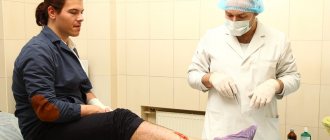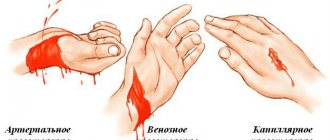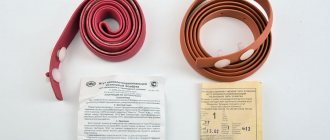When bleeding, the rate of blood loss can be a concern, so in many cases you need to act quickly. First aid measures depend on the type of bleeding, its location, the nature of the injury and some other factors. In this article we will talk about ways to combat blood loss in different situations.
Guidelines and a poster for stopping bleeding on the stand are available after the article.
Types of bleeding
Most often, bleeding is grouped according to anatomical principles, taking into account the damaged blood vessel.
According to this classification, there are 3 main types of bleeding :
- Arterial. The blood stream is pulsating and scarlet in color. It is characterized by a high rate of blood loss and is the most dangerous.
- Venous. The blood is dark and may flow more slowly.
- Capillary. The blood is bright red, appears slowly and in a small volume. Sometimes it appears in the form of small drops on the surface of the skin.
Separate topic: Types of external bleeding
There is also parenchymal bleeding, which cannot be seen. It occurs when the integrity of the liver, pancreas, and kidneys is damaged. Parenchymal bleeding is similar in nature to capillary bleeding, but poses a great danger to life. With deep penetrating wounds or damage to the integrity of internal organs, bleeding can be mixed.
Internal and external bleeding are also distinguished according to the direction of blood release. In the first case, blood accumulates in the cavities of the body, in the second, it comes out through wounds.
We recommend additional material: First aid for wounds
Symptoms of bleeding from an artery
There are several types of arteries in the human body, each of which plays an important role for the normal functioning of all organs and systems. The femoral, carotid, axillary and other arteries supply the body with blood and oxygen. With significant blood loss, the internal organs do not receive enough oxygen and nutrients, as a result of which the heart stops. It is not difficult to distinguish arterial bleeding from venous bleeding. Blood from the vein oozes slowly and has a brown tint.
In case of arterial bleeding, the following signs are observed:
- blood is scarlet, liquid;
- the flow of blood from the wound is rapid, often flowing like a fountain;
- the victim’s body temperature drops sharply;
- there is pulsation of blood with heartbeats, while below the site of injury the pulsation is impaired or completely absent;
- a person’s skin becomes pale and bluish;
- The patient’s general well-being worsens, blood pressure drops, dizziness, convulsions, and loss of consciousness develop.
By quickly identifying the signs of arterial bleeding and providing the person with the necessary first aid, his life can be saved. The reaction of others should be lightning fast, since when arteries are damaged, especially large ones, we are talking about a few minutes.
Rules for applying a tourniquet
A tourniquet is applied only to stop arterial bleeding, and also if an arm or leg was amputated as a result of injury. In other cases, the use of a tourniquet is not advisable due to the high degree of injury to the skin and soft tissues. To temporarily stop bleeding, you can use an Esmarch tourniquet or a handy rubber material.
Rules for applying a tourniquet for bleeding
Basic rules and sequence of applying a tourniquet:
- If possible, raise your arm or leg for a few seconds and fix it in a comfortable position - this will lead to the outflow of venous blood.
- The tourniquet is applied over clothing or a piece of fabric is placed under it. This is necessary to protect the skin.
- The first two turns need to be made as tight as possible, they are the ones who stop the blood, while the crosshair is applied on the back side of the artery.
- The maximum duration of applying a tourniquet in the warm season should not exceed 90 minutes, in the cold season - 60 minutes. If during this time the victim cannot be taken to the hospital, the tourniquet should be loosened for 10-15 minutes and the artery should be pressed with a finger. Then the tourniquet is applied again, 1-2 cm above or below the previous location. The duration of applying a tourniquet to children should not exceed an hour.
- The time for applying the tourniquet must be written down and attached in a visible place. In reality, due to problems with drawing up (searching for paper and pens in field or combat conditions, while there are more pressing tasks of saving the life of the victim) and preserving (the paper gets soaked in blood and spreads or is simply lost) notes, in modern In practice, it is customary to write the time of application of the tourniquet with a marker directly on a visible place on the body, for example, it could be the forehead; it is recommended to indicate the name of the rescuer or the person who applied the tourniquet.
Esmarch rubber hemostatic tourniquet
Indications:
- traumatic amputation of a limb;
- inability to stop bleeding with other known means.
Advantages:
- quite fast and the most effective way to stop bleeding from the arteries of the limb.
Flaws:
- the use of a tourniquet leads to complete bleeding of the distal limbs due to compression of not only damaged great vessels, but also collaterals, which for more than 2 hours can lead to gangrene;
- nerve trunks are compressed, which causes post-traumatic plexitis with subsequent pain and orthopedic syndrome;
- cessation of blood circulation in the limb reduces the resistance of tissues to infection and reduces their regenerative abilities;
- the use of a tourniquet can cause severe vasospasm and lead to thrombosis of the operated artery;
- restoration of blood circulation after use of a tourniquet contributes to the development of tourniquet shock and acute renal failure;
- the use of a tourniquet is impossible on the torso or is limited in anatomically difficult areas.
Errors:
- its use without indications, that is, for venous and capillary bleeding;
- application on a naked body;
- far from the wound;
- weak or excessive tightening;
- poor fastening of the ends of the tourniquet;
- lack of accompanying note;
- use more than 2 hours;
- covering the tourniquet with a bandage or clothing.
If there is severe bleeding, a tourniquet is applied to the upper third of the shoulder or middle third of the thigh. In these areas, the anatomical location of the humerus and femur makes it possible to stop the bleeding with maximum efficiency. Applying a tourniquet in other places will not give the desired result. If a limb is torn off, applying a tourniquet is mandatory even in the absence of bleeding.
If the tourniquet is applied correctly, characteristic signs will appear after a while. The limb below the application site will turn pale and cold, the bleeding will stop, and the peripheral pulse will not be palpable. The intersection of the tourniquet should be on the outside of the arm or leg, since the artery is located on the axillary side.
What is the danger
As already mentioned, blood is the transporter of oxygen molecules and other nutrients throughout the human body. Saturating the tissues of the heart, brain and other organs, the blood takes carbon dioxide and other metabolic products from them. The heart and central nervous system are most sensitive to disruption of this process. If there is no blood supply to the brain for more than 6 minutes, death will occur in most cases.
In addition, there is such a thing as vascular collapse. Vascular tone is ensured by the continuous flow of blood through them. If this process is disrupted due to a sharp drop in the volume of circulating blood in the body, vascular shock or collapse occurs.
Important! Failure to help a patient with arterial bleeding leads to death due to oxygen starvation as a result of severe blood loss.
First aid
For arterial bleeding
If an artery is damaged, the bleeding is rapid, so you cannot hesitate. After quickly assessing the victim’s condition, measures must be taken to temporarily stop the bleeding. First, the artery is pinched with a finger; for this, certain points are used:
- If there is bleeding in the face, press the corner of the lower jaw with your thumb.
- In case of bleeding from the head, press on the area of the temporal bone in front of the ear.
- In case of arterial bleeding in the area of the shoulder joint, press the subclavian artery to the rib.
- If the hand is damaged, press the brachial artery to the bone from the side of the shoulder.
- If the integrity of the femoral artery is compromised, press with your fist on the pubic bone in the groin area.
First aid for arterial bleeding
After finger pressure, a tourniquet is applied in compliance with the rules described above. If you don’t have a tourniquet or similar material at hand, you can apply a twist. To do this, use a piece of twine or fabric. A loop is made from the material and placed on the desired area of the limb. A metal or wooden rod is inserted into the loop, with the help of which the bandage is twisted. Further actions are the same as when stopping bleeding using a tourniquet.
For venous bleeding
In most cases, it is easier to stop bleeding from a vein than from an artery, so neither a tourniquet nor a twist is practically used.
The algorithm for providing first aid is as follows:
- The wound is covered with several layers of bandage, napkins or any clean piece of fabric.
- Sterile cotton wool is placed on top.
- Fix everything tightly with a bandage, scarf or piece of fabric of the required width.
To consolidate the effect, the damaged limb is raised so that it is higher than the body and fixed. If it is not possible to apply a bandage, the wound is packed with a tightly rolled bandage. Sometimes this is enough to stop the bleeding.
If there is severe bleeding from a vein, a pressure bandage may be useless. In this case, you need to apply a tourniquet and apply an ice pack to the wound. After this, the victim must be taken to the nearest hospital.
For capillary bleeding
In most cases, capillary bleeding does not pose a threat to the life of the victim and, if first aid measures were correct, does not cause complications.
To stop bleeding during external bleeding, you must adhere to the following sequence:
- Treat the skin area with any antiseptic.
- Apply a napkin and secure it with a bandage;
- If a limb is injured, raise it relative to the body.
With various injuries or diseases, nosebleeds may begin. It occurs in case of damage to the blood vessels located in the mucous membrane; it can stop on its own, but in severe cases, first-aid treatment will be required.
First of all, you need to press the wing of the nose to the nasal septum. For minor damage to blood vessels, the bleeding should stop after 10 minutes. If this does not happen, a nasal tamponade is performed. In case of nosebleeds, you need to monitor the well-being of the victim and warn him that he needs to breathe through his mouth.
First aid for types of bleeding
First aid for venous bleeding
With venous bleeding, a stream of blood comes to the surface at high speed so that it does not allow a blood clot to form and stop the bleeding.
As a result, a person may lose a large amount of blood.
Algorithm for providing assistance:
- Raise the injured limb upward;
- Cover the wound with a bandage or clean cloth folded several times;
- Cover the wound tightly with a bandage.
In case of severe venous bleeding, a tourniquet is applied and then cold is applied to the wound. Next, go to the hospital for help.
Penetrating chest injury
- close the hole tightly
- apply cold
- not allowed to speak
- breathe deeply
Signs and symptoms of penetrating chest injury
- white or bloody foam at the mouth
- the same one at the wound site
Glue the bag, a piece of plastic with tape or adhesive tape, check: if there is an entrance hole, then there may be an exit hole (in the case of a gunshot wound, it can be 10 times larger than the entrance hole), if it is small, you can seal it.








